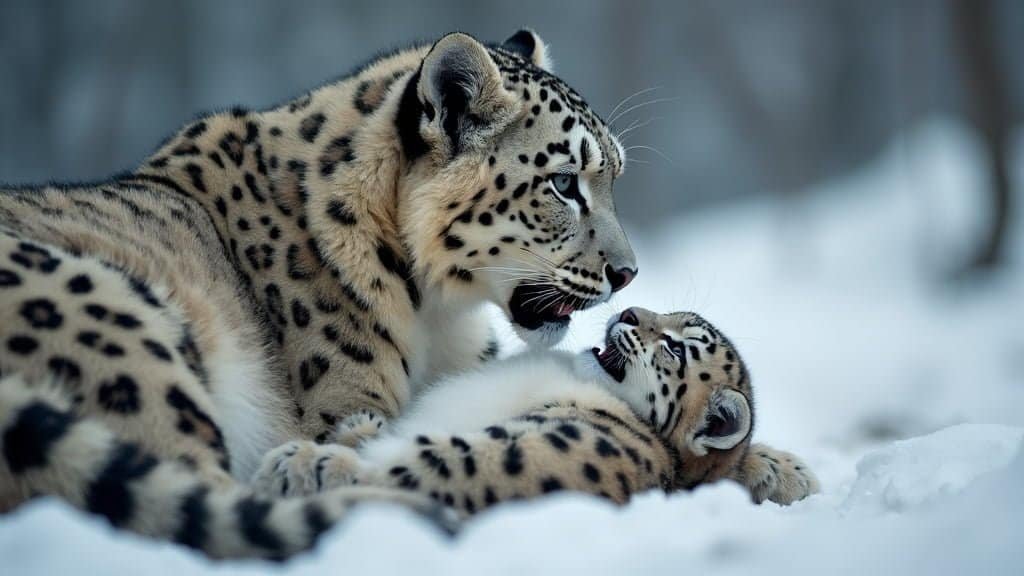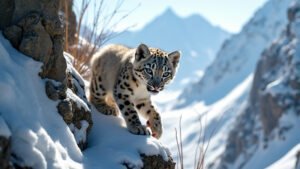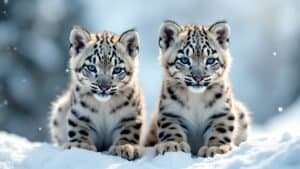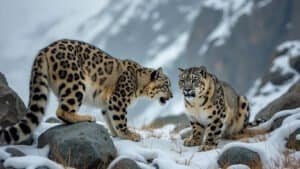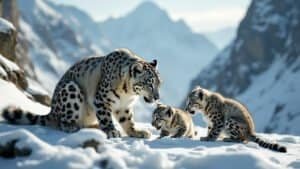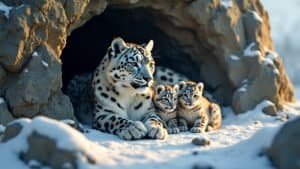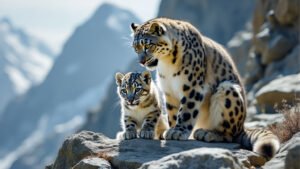Introduction
Snow leopards, elusive and majestic creatures of the high mountains, have a unique and fascinating process for giving birth and raising their cubs
This article explores the various aspects of their birthing habits, including the preferred habitats for birthing, the careful selection of birthing locations, and the intricate structure of their dens
We will also delve into the early development stages of snow leopard cubs, the threats they face, and the efforts made to protect these vulnerable young animals
Preferred Habitats for Birthing
Snow leopards, also known as “ghosts of the mountains,” have specific habitat preferences when it comes to giving birth and raising their cubs
These majestic felines inhabit the rugged and remote mountainous regions of Central and South Asia, including countries like China, Mongolia, India, Pakistan, Afghanistan, and Nepal
The following sections will explore the key characteristics of the habitats they prefer for birthing and raising their young
Rocky and Mountainous Terrain
Snow leopards primarily inhabit rocky and mountainous terrains that provide ample cover and seclusion
These areas often have steep slopes, rocky outcrops, and cliffs, which are ideal for creating secure dens. The high altitudes, typically ranging from 9,800 to 14,800 feet, offer a natural barrier against predators and human disturbances
These rugged terrains are not only difficult for potential threats to navigate but also provide excellent vantage points for the snow leopards to keep a watchful eye on their surroundings. The rocky environment also helps camouflage the snow leopards, thanks to their spotted fur, which blends seamlessly with the rocky landscape
Secluded and Inaccessible Areas
Seclusion is a critical factor in the selection of birthing habitats. Snow leopards choose areas that are difficult to access, ensuring the safety and privacy needed for raising their cubs. These secluded locations minimize the risk of encounters with predators such as wolves and birds of prey, as well as human activities
Inaccessibility is often achieved through the selection of den sites located in high-altitude regions with harsh weather conditions. These areas are typically far from human settlements and livestock grazing areas, reducing the likelihood of human-wildlife conflicts
Climate and Vegetation Factors
The climate of snow leopard habitats is characterized by cold temperatures and significant snowfall, particularly during the winter months
Snow leopards are well-adapted to these harsh climatic conditions, with their thick fur and large paws that act like snowshoes. The cold climate also plays a role in limiting the presence of other large predators that could pose a threat to the cubs
Vegetation in these habitats is sparse, consisting mainly of grasses, shrubs, and small trees. The limited vegetation provides enough cover for the leopards to remain hidden while allowing them to maintain a clear line of sight for spotting potential threats
Additionally, the prey availability in these areas, such as blue sheep, ibex, and marmots, supports the nutritional needs of the mother and her growing cubs
Official Studies and Data
Studies conducted by organizations such as the Snow Leopard Trust and the World Wildlife Fund (WWF) have provided valuable insights into the habitat preferences of snow leopards
According to a study published in the Journal of Mammalogy in 2016, snow leopards exhibit strong site fidelity to specific birthing areas, often returning to the same locations year after year (Johansson et al., 2016)
Furthermore, a research project by the Global Snow Leopard and Ecosystem Protection Program (GSLEP) has highlighted the importance of protected areas and conservation efforts in preserving these critical habitats
These studies emphasize the need for continued protection and monitoring of snow leopard habitats to ensure the survival of this elusive species
Choosing the Birthing Location
Snow leopards exhibit a highly selective process when choosing birthing locations, ensuring the safety and optimal growth environment for their cubs. This section delves into the various factors influencing den selection, potential threats considered during this process, and real-world case studies highlighting known birthing sites
Factors Influencing Den Selection
Snow leopards consider several critical factors when selecting a birthing den, balancing security, accessibility, and environmental conditions
Security and Seclusion
The primary concern for a mother snow leopard is the security of her cubs. Dens are typically located in remote, secluded areas that offer natural protection against predators and human interference
These locations are often situated on steep cliffs or within rocky crevices, which are difficult for predators to access. The rugged terrain provides an excellent vantage point for the mother to monitor her surroundings and detect any approaching danger
Proximity to Prey
Another crucial factor is the proximity to prey. Snow leopards choose dens near areas with abundant prey to minimize the time the mother spends away from her cubs
Typical prey includes blue sheep, ibex, and other mountain ungulates, which are commonly found in the snow leopard’s natural habitat. Having prey nearby ensures that the mother can adequately nourish herself and produce enough milk for her cubs
Environmental Conditions
Environmental conditions such as temperature, shelter from the elements, and availability of water are also important
Snow leopards prefer dens that offer shelter from extreme weather conditions, such as heavy snowfall or strong winds. The dens are often positioned to take advantage of natural features that provide insulation and protection from the elements
Predatory and Environmental Threats
Snow leopards face various threats in their natural habitat, influencing their choice of birthing locations
Natural Predators
Although adult snow leopards have few natural predators, their cubs are vulnerable to attacks from other carnivores, such as wolves and large birds of prey. Selecting a well-protected den helps mitigate these risks. The high altitude and rugged terrain of their chosen dens act as a natural defense mechanism against these predators
Human Disturbances
Human activities pose a significant threat to snow leopards and their cubs. Poaching, habitat destruction, and human-wildlife conflicts can endanger their survival. Snow leopards tend to avoid areas with high human activity, preferring remote regions less likely to be disturbed by humans
Case Studies of Known Birthing Sites
Ladakh, India
In Ladakh, India, researchers have identified several key birthing sites. One notable study conducted by the Snow Leopard Trust in collaboration with local communities documented a female snow leopard using a remote cave system to give birth. The area was characterized by steep cliffs and abundant prey, providing an ideal environment for raising cubs
Tost Mountains, Mongolia
The Tost Mountains in Mongolia are another critical area for snow leopard birthing. A long-term study by the Snow Leopard Conservation Foundation revealed that females frequently return to the same den sites, indicating strong site fidelity. These dens are typically located in high-altitude regions with rocky outcrops and limited human presence
Kyrgyzstan
In Kyrgyzstan, conservationists have identified multiple birthing sites within the Sarychat-Ertash Nature Reserve. These dens are located in rugged, high-altitude terrain, far from human settlements. The protected status of the reserve helps ensure the safety of these critical habitats
Research and Conservation Efforts
Research organizations and conservation groups, such as the Snow Leopard Trust and Panthera, are actively involved in studying and protecting snow leopard birthing sites. Their efforts include tracking and monitoring snow leopard populations, engaging local communities in conservation initiatives, and promoting policies that protect critical habitats
For example, a study published in Oryx in 2018 highlighted the importance of community-based conservation programs in reducing human-wildlife conflicts and preserving snow leopard habitats (McCarthy et al., 2018). These programs involve local herders in monitoring and protecting snow leopards, creating a more sustainable coexistence
Structure and Size of Snow Leopard Dens
The structure and size of snow leopard dens play a crucial role in providing a safe and nurturing environment for the cubs. This section examines the typical characteristics of snow leopard dens, their construction and maintenance, and regional variations that influence den structures
Typical Den Characteristics
Snow leopard dens are carefully chosen to ensure the highest level of security and comfort for the mother and her cubs. These dens are typically located in remote, rugged areas, often within rocky outcrops, caves, or crevices
Size and Dimensions
The size of a snow leopard den can vary depending on the geographical location and the specific needs of the mother. Generally, dens are spacious enough to accommodate the mother and her cubs, providing sufficient room for movement and nursing
The entrance to the den is usually narrow, making it difficult for larger predators to enter, while the interior expands into a wider, more comfortable space
According to a study published in the Journal of Zoology in 2015, snow leopard dens typically measure between 3 to 6 feet in length and 2 to 3 feet in height, with a similar width. The den’s dimensions are designed to provide maximum protection from external threats while ensuring the comfort of the cubs (Sharma et al., 2015)
Insulation and Comfort
The interior of the den is often lined with soft materials such as grass, moss, and fur shed by the mother, providing insulation against the cold and a comfortable resting area for the cubs. These materials help maintain a stable temperature within the den, crucial for the survival of the newborn cubs, who are particularly vulnerable to cold temperatures
The strategic placement of the den also ensures protection from the elements. Many dens are positioned to face away from prevailing winds and are shielded by natural rock formations, which help prevent snow and rain from entering the den
Construction and Maintenance
Snow leopards do not build dens in the traditional sense but rather utilize natural formations to create secure birthing sites. The process involves selecting a location that offers the necessary security and comfort and then making minimal modifications to enhance these natural features
Site Selection
The selection of a den site is a meticulous process. The mother snow leopard often inspects several potential sites before settling on the most suitable one. Factors such as elevation, accessibility, and proximity to prey are considered during this process
The chosen site is typically revisited and used for several years, indicating the importance of specific locations for birthing
Maintenance
While snow leopards do not actively construct dens, they do maintain and modify them as needed. This may involve adding more insulation material or clearing out debris to ensure the den remains safe and comfortable
The mother leopard is responsible for maintaining the den, ensuring it remains a secure environment for her cubs throughout their early development stages
Variations Across Different Regions
The structure and characteristics of snow leopard dens can vary significantly depending on the region. These variations are influenced by local environmental conditions, available natural formations, and regional threats
Central Asia
In the high-altitude regions of Central Asia, such as the Himalayas and the Tibetan Plateau, snow leopards often use caves and rocky crevices as dens. These natural formations provide excellent protection against the harsh weather conditions and are typically well-insulated with natural materials
Mongolia
In Mongolia, snow leopards tend to use more open rocky outcrops and boulder fields for their dens. These areas offer good visibility and ample cover, allowing the mother to keep an eye on her surroundings while remaining hidden from potential threats
Russia
In the mountainous regions of Russia, snow leopards have been observed using dense forested areas with rocky shelters. The combination of forest cover and rocky formations provides an ideal environment for raising cubs, offering both protection and proximity to prey
Official Studies and Data
Research on snow leopard dens has been extensive, with various studies providing valuable insights into their structure and characteristics
A notable study by the Snow Leopard Network in 2017 emphasized the importance of understanding den site selection and structure for effective conservation efforts (Jackson et al., 2017)
Additionally, data collected through camera traps and GPS collaring have helped researchers identify and monitor active den sites, contributing to a better understanding of snow leopard behavior and habitat requirements
Development of Snow Leopard Cubs
The development of snow leopard cubs is a critical period that determines their survival and eventual integration into the wild. This section explores the early development stages of cubs, the mother-cub bonding process, and the significant milestones during their first year
Early Development Stages
Snow leopard cubs are born blind and helpless, relying entirely on their mother for nourishment and protection. The initial weeks after birth are crucial as the cubs undergo rapid physical and sensory development
Birth and Early Days
Snow leopard cubs are usually born between late spring and early summer, after a gestation period of approximately 93 to 110 days
Litters typically consist of 1 to 3 cubs, although larger litters have been recorded. At birth, cubs weigh between 11 to 21 ounces and are covered in a soft, grayish fur that provides some insulation against the cold
During the first week, the cubs’ eyes remain closed, and they are entirely dependent on their mother for warmth and nutrition. The mother leopard stays close to the den, ensuring the cubs are safe and well-fed. She will leave the den only briefly to hunt, returning frequently to nurse and care for her young
Sensory and Motor Development
By the end of the second week, the cubs’ eyes begin to open, marking a significant milestone in their development
Their vision improves gradually over the next few weeks, allowing them to explore their immediate surroundings within the den. The cubs also start developing their sense of smell and hearing, which are essential for their survival
Motor skills begin to develop during this period, with cubs starting to crawl and later on, attempting to walk. The mother encourages these activities, often engaging the cubs in playful interactions that help strengthen their muscles and coordination
Mother-Cub Bonding and Care
The bond between a mother snow leopard and her cubs is incredibly strong and plays a vital role in the cubs’ development and survival
Nursing and Weaning
The mother nurses her cubs frequently, providing them with essential nutrients through her milk. This period of exclusive nursing typically lasts for about two months, after which the cubs begin to be introduced to solid food
The mother brings back small prey to the den, teaching the cubs to recognize and consume meat. This gradual weaning process ensures that the cubs receive the necessary nutrition while developing their hunting skills
Protection and Teaching
Throughout their early months, the mother leopard is fiercely protective of her cubs. She carefully monitors the den’s surroundings, keeping potential threats at bay. The cubs learn essential survival skills by observing their mother, including stalking, pouncing, and other hunting techniques
The mother also teaches the cubs how to recognize and avoid dangers, such as larger predators and human activity. This period of learning and bonding is critical for the cubs’ future independence
Milestones in the First Year
The first year of a snow leopard cub’s life is marked by several key milestones that prepare them for survival in the wild
Exploration and Play
By the age of three months, the cubs are more active and start venturing outside the den under their mother’s watchful eye. This exploration is crucial for developing their physical and cognitive abilities
Play behavior, including chasing, wrestling, and mock hunting, is common and helps the cubs practice their hunting skills and build strength
Hunting Skills
Around six months of age, the cubs begin to accompany their mother on hunting trips. This is a critical learning phase where they observe and participate in hunting activities. The mother demonstrates stalking, ambushing, and other techniques, gradually allowing the cubs to attempt hunting smaller prey on their own
Independence
By the time they reach one year of age, snow leopard cubs are significantly more self-sufficient. They have learned essential survival skills and can hunt small to medium-sized prey. However, they often remain with their mother for up to 18-24 months, continuing to hone their skills and gain experience
Research and Observations
Scientific studies and observations have provided valuable insights into the development of snow leopard cubs. A study published in Biological Conservation in 2013 highlighted the importance of maternal care in cub survival, noting that cubs with attentive mothers had higher survival rates (McCarthy et al., 2013)
Additionally, field research conducted by the Snow Leopard Conservancy has documented the critical role of play and exploration in the cognitive and physical development of cubs
Threats to Snow Leopard Cubs
Snow leopard cubs face numerous threats from both natural predators and human activities. Understanding these threats is crucial for implementing effective conservation strategies to ensure the survival of this vulnerable species
This section examines the primary threats to snow leopard cubs, conservation efforts to mitigate these threats, and success stories in cub survival
Natural Predators and Human Threats
Snow leopard cubs are vulnerable to a range of natural and human-induced threats that significantly impact their survival rates
Natural Predators
While adult snow leopards have few natural predators, their cubs are at risk from several carnivores and large birds of prey
Wolves, Eurasian lynxes, and golden eagles are among the primary natural threats to snow leopard cubs. These predators can pose a significant danger, particularly when the mother is away hunting
To mitigate these risks, mother snow leopards choose den sites that are difficult for predators to access, such as rocky crevices and high-altitude locations. The natural camouflage provided by their fur also helps protect the cubs from being easily spotted by predators
Human Activities
Human activities represent a substantial threat to snow leopard cubs. These threats include habitat destruction, poaching, and human-wildlife conflicts:
Habitat Destruction: The expansion of human settlements, mining, and infrastructure development in mountainous regions lead to habitat fragmentation and loss. This encroachment reduces the available safe spaces for snow leopards to establish dens, increasing the likelihood of human-cub encounters
Poaching: Snow leopards are targeted by poachers for their fur and bones, which are highly valued in illegal wildlife trade. Cubs, although less targeted, can be orphaned when their mothers are killed by poachers. This leaves them vulnerable to starvation and predation
Human-Wildlife Conflict: Snow leopards occasionally prey on livestock, leading to retaliatory killings by herders. This conflict is exacerbated by the loss of natural prey due to overgrazing by livestock, driving snow leopards to target domesticated animals. Cubs are at higher risk in areas with intense human-wildlife conflict, as they are more likely to be left unattended while their mothers hunt
Conservation Efforts and Protection Measures
Efforts to protect snow leopard cubs focus on habitat preservation, anti-poaching initiatives, and community engagement to reduce human-wildlife conflicts
Habitat Preservation
Protecting and restoring snow leopard habitats are critical components of conservation strategies. Initiatives such as the establishment of protected areas, wildlife corridors, and habitat restoration projects help ensure that snow leopards have safe places to give birth and raise their cubs:
Protected Areas: Creating and maintaining national parks and reserves in snow leopard habitats helps reduce human encroachment and provides a safe haven for wildlife. For instance, the Sarychat-Ertash Nature Reserve in Kyrgyzstan is a key area for snow leopard conservation, offering a protected environment for cubs to thrive
Wildlife Corridors: Establishing corridors that connect fragmented habitats allows snow leopards to move safely between regions, increasing their chances of finding suitable den sites and maintaining genetic diversity
Anti-Poaching Initiatives
Combating poaching is essential for the survival of snow leopards and their cubs. Various organizations implement anti-poaching measures, including increased patrols, the use of technology for monitoring, and stricter enforcement of wildlife protection laws:
Increased Patrols: Regular patrolling of snow leopard habitats by rangers helps deter poaching activities and allows for immediate intervention if poaching is detected
Technology for Monitoring: The use of camera traps, GPS collars, and drones enhances the ability to monitor snow leopard populations and detect illegal activities. These technologies provide valuable data on snow leopard movements and help identify poaching hotspots
Legal Enforcement: Strengthening and enforcing wildlife protection laws are crucial for reducing poaching. Countries within the snow leopard range are working to implement stricter penalties for illegal hunting and trade
Community Engagement
Engaging local communities in snow leopard conservation is vital for reducing human-wildlife conflicts and fostering coexistence:
Livestock Protection: Providing herders with tools and strategies to protect their livestock, such as predator-proof enclosures and guard animals, helps reduce retaliatory killings of snow leopards. Programs like these have been successfully implemented in regions like Ladakh, India, where community-based conservation efforts have significantly reduced livestock losses
Education and Awareness: Educating communities about the importance of snow leopards and the role they play in the ecosystem helps build support for conservation initiatives. Workshops, school programs, and community meetings are effective ways to raise awareness and promote coexistence
Success Stories in Cub Survival
Conservation efforts have led to several success stories in the survival of snow leopard cubs
Ladakh, India
In Ladakh, community-based conservation programs have led to a significant reduction in human-wildlife conflicts. Herders have adopted predator-proof livestock enclosures, and awareness campaigns have increased tolerance towards snow leopards. As a result, there has been an increase in snow leopard cub survival rates in the region
Mongolia
In Mongolia, the Snow Leopard Trust’s long-term research and community engagement efforts have contributed to the successful protection of snow leopard dens. The implementation of livestock insurance programs has reduced retaliatory killings, allowing more cubs to reach adulthood
Research and Conservation Data
Numerous studies have documented the impact of conservation efforts on snow leopard cub survival
A study published in Conservation Biology in 2020 highlighted the effectiveness of community-based conservation programs in reducing livestock depredation and increasing cub survival rates (Alexander et al., 2020)
Additionally, data from camera traps and GPS collaring provide valuable insights into cub survival and the effectiveness of anti-poaching measures
Conclusion
Snow leopards, often called the “ghosts of the mountains,” are magnificent creatures that require specific conditions for giving birth and raising their cubs
These elusive cats select rugged, high-altitude terrains to ensure the safety and development of their young. From choosing secluded and inaccessible birthing locations to creating dens that offer protection and comfort, snow leopards demonstrate remarkable adaptability
In their early development stages, snow leopard cubs rely entirely on their mothers for nutrition and protection. The bond between mother and cub is crucial for teaching survival skills and ensuring the cubs’ growth into independent hunters
However, snow leopard cubs face numerous threats from natural predators and human activities, making conservation efforts essential for their survival
Efforts to protect snow leopard cubs include habitat preservation, anti-poaching initiatives, and community engagement. Success stories from regions like Ladakh, India, and Mongolia highlight the positive impact of these initiatives. Continued research and conservation work are vital to safeguarding snow leopards and their habitats, ensuring that these majestic animals continue to thrive in the wild
